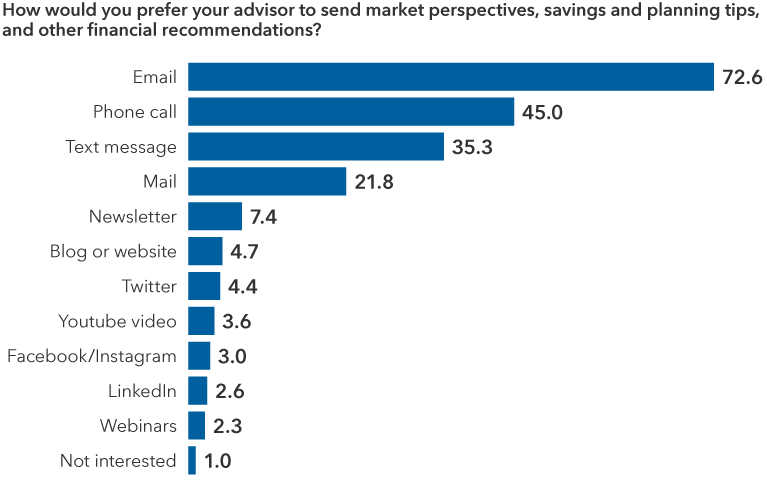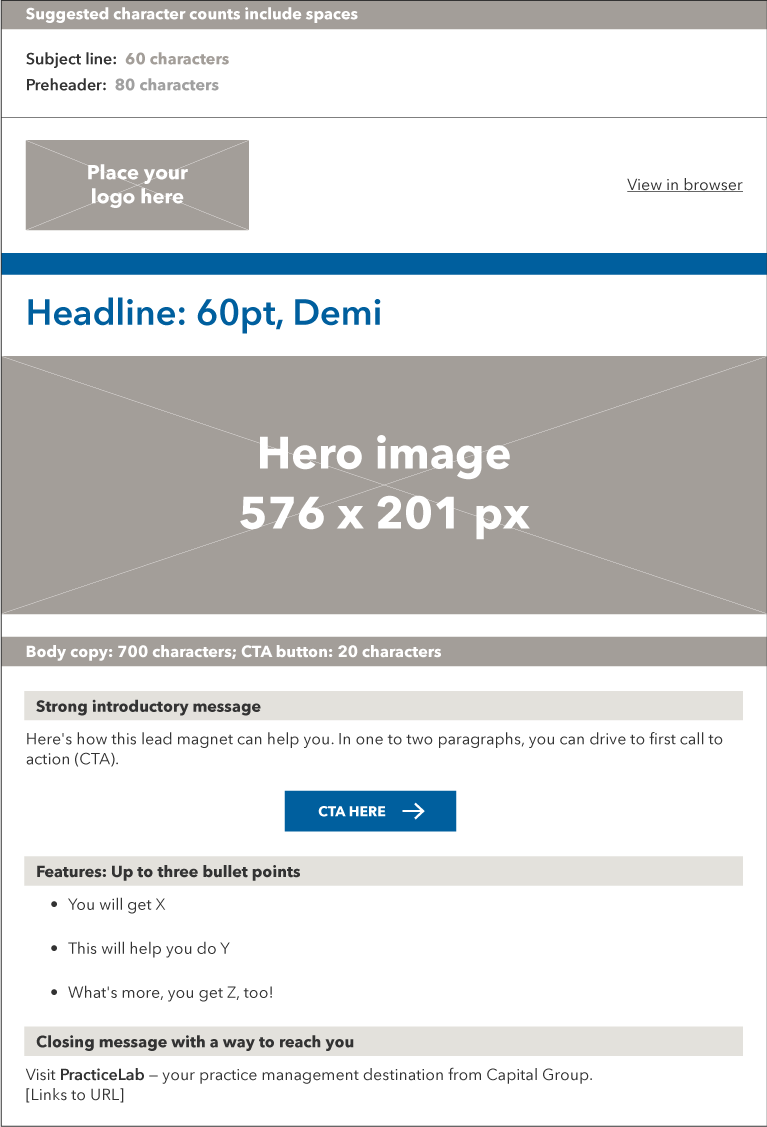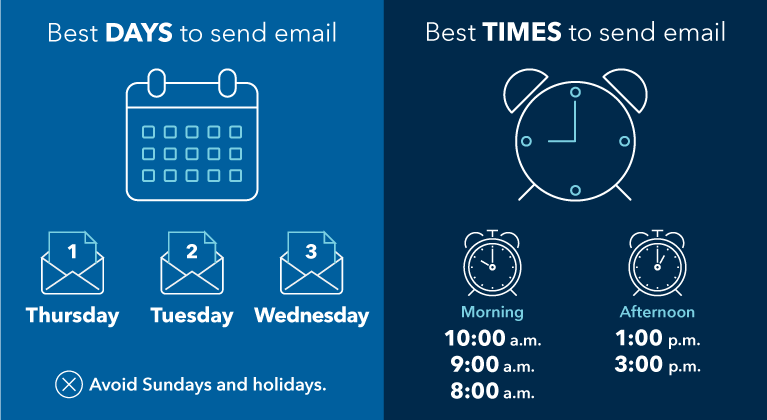Client Relationship & Service
7 MIN ARTICLE
If email feels like old news or your communications are not breaking through, it may be time to refresh your strategy. A great email strategy can help make even a solo advisory practice feel like an enterprise, driving everything from prospecting to loyalty and retention.
A recent report by Y Charts, How Can Advisors Better Communicate with Clients?, found that 90% of clients say frequency of advisor communication and information sharing play a big role in their likelihood to stay with them and make a referral. The same study found that more than 72% of clients prefer to receive advisor perspectives via email, compared to 45% who prefer phone calls. And while advisors at larger firms have built-in email marketing strategies, all advisors have the capability for frequent, even personalized, communications via email.
Email the clear preference among clients

Source: Y Charts, “How Can Advisors Better Communicate with Clients?: Comparing the State of Advisor-Client Relationships Pre and Post-Pandemic,” 2022.
Here’s how to update your email strategy to help you attract new prospects while building client loyalty.
Build your email list with a “lead magnet”
You likely already have an email distribution list, full of the names and email addresses of clients to whom you send important or regular communications. Build on that list, with as many additional emails you can gather. The point is to build now and segment later. Any (or nearly any) lead is a good lead.
To attract new clients, it helps to have what’s known as a “lead magnet.” A lead magnet is a valuable resource that can be offered in exchange for an email sign-up. Lead magnet examples include financial e-books, regular newsletters, compelling infographics, video case studies, or consumer-friendly webinars or events.
If you do any content marketing, you can build a lead magnet out of your most popular topics or content. If you are just starting to create content, most investors want to learn more about retirement, home ownership, smart goals and investment strategies. Providing key information on these topics may help get you an email address.
Once you have a lead magnet, here are ways to build an email list:
Highlight your lead magnet on your website. Create a prominent spot or link where visitors can sign up to get your lead magnet content by providing a name and email.
Promote your lead magnet on social media channels. Build a post that encourages your followers to sign up for the content. You can also promote other content on your website that links to your lead magnet, creating a journey for your prospect before asking them for a sign-up.
Attend industry events. Wherever you network with potential clients and centers of influence, market your lead magnet. Put out a clipboard as well as a digital tablet to use for sign-ups, and deputize a team member to assist the collection of emails.
Create a referral program. Find a way to reward existing clients who refer friends to share an email address with you.
Consider paid ads. Once you have refined your email strategy, you can use paid advertising to amplify your lead magnet via platforms like Facebook or Google.
Segment your email list
Once your list starts to become more robust, you can create different subsets or audience segments. For example, your first segment would be existing clients. Another segment would be individuals who get marketing emails. You could also segment by new or onboarding clients, prospective clients or new prospects, center-of-influence contacts and associates, friends and family of clients, one-time site visitors, topic interest, and so on.
However you segment your list, you can target your strategy and your messages to meet the interests or needs of each segment. This increases the chances of different types of people engaging with your content and your practice.
If you use customer relationship management (CRM) software, such as Salesforce, Redtail, Envestnet or AdvisorEngine, you should be allowed to easily segment email lists and personalize your messaging.
Tell a story with email
Client communication emails tend to be fairly straightforward, but marketing emails and newsletters need to do much more. Tell a story, solve a problem, answer a question, or surprise and delight with information. Whatever you do, send something worth reading. You can provide themed content, tackle life stages, offer interesting or thoughtful resources, or comment on markets, economic conditions or news.
Capital Group, for example, offers weekly takes on the market and the economy, as well as more evergreen resources for financial life stage decisions, which can easily be shared with clients.
Use templates for instant professionalism
Messaging and tone are important in a marketing email, which can feel more friendly than other types of communication. But it is important to keep a professional tone and presentation. Templates can help. Email templates are preset formulas and layouts that you can use to help create a clear and efficient marketing message.
For example, most emails will contain a handful of similar details:
Subject line: The first detail your clients will see in their inbox, subject lines should be strong and compelling. You can feature benefits, ask a question, provide a solution to a common problem or find other ways to grab a reader’s attention. To make sure the message is not cut off, limit the character count to about 60 characters including spaces.
Preheader: This is that line of summary text often viewed when looking at your email list in your inbox. It should also be attention-grabbing, while providing more context or information regarding the email’s contents. Keep the count under 80 characters, including spaces.
Logo: Having your company name or logo listed in a prominent spot near the top of the email is a nice touch of branding.
Headline/intro: A bold announcement or introductory statement at the top can keep your audience reading. Keep it short at around 60 characters or less.
Hero image: These days, many emails use imagery as a way of highlighting a product, enforcing a message or just creating a thematic tone. You can use stock photos or create a simple graphic.
Body copy: This descriptive block of text is the place to answer questions in a brief and clear way. It helps to keep the paragraphs short and limit the text to around 700-1,000 characters, although lengths can vary.
Features: Imagine your audience has no time and heads straight to the bullets. Highlight the benefits of your offering with these strong value propositions.
Call to action (CTA) with link: Your CTA is what you want the user to do. The language should be specific, compelling and powerful. It helps to have a link to take them to the next step.
Closing: Not every email needs to end with a signature, but if it reads like a personalized letter, your email should include a proper closing message.
An email template in action
A consistent layout can help make your message even stronger. Here’s an example of an email template you can use for any type of communication.

Source: Capital Group, 2023
There are many free email templates to be found online, which can typically be customized to include a brand logo, colors and feel of your business, while providing reminders of including important features, calls to action and links encouraging your audience to take whatever next step you’d like them to take. Some will even offer words and sentences to use to promote different topics or types of promotion. Check out Brevo, Hubspot, MailChimp or Constant Contact to see what you might get for free compared to paid options. Capital Group’s Marketing Lab is another free resource for registered investment advisors who sign up, allowing you to create bespoke emails with a few simple inputs. Just remember: These templates are often used as lead magnets, so you may have to give an email address to access them.
Consider tools for easy personalization, measurement and targeting
The latest communication tools for advisors are designed with productivity in mind and make it easier for the average advisor to do digital marketing. Many digital tools can be added to your customer relationship management software CRM to allow you to personalize communications by pulling from your database.
Some platforms can be integrated with any database and offer email templates, regular newsletters or marketing content, automated responses, and lead-nurturing campaigns. Some popular programs for wirehouse, independent and registered investment advisors include ReachStack, Advisor Stream, FMG Suite and Snappy Kraken.
Depending on the program, you may also get the ability to target certain client demographic types or “lookalikes” of your favorite clients. You will also get the ability to track campaigns and better measure the success of your efforts.
Test and learn
Trying, tracking, overcoming missteps and celebrating wins — it’s all part of the process, and it can be part of the fun. Use your segmenting skills to send different versions of an email to test subject lines, content topics and calls to action, and learn what resonates best with different audiences. Testing and learning can help you optimize future emails based on these results to improve email open and click-through rates.
Even testing the days and times you send email may help you figure out an optimal strategy. According to content marketing company CoSchedule, it’s generally best to send email on weekdays, with Thursday being the day people are most likely to open it, followed by Tuesday and Wednesday. (Thursdays and Tuesdays are best if sending multiple emails in a single week.) The best times to send emails that will get opened are generally midmorning or midafternoon, although those sent right when the workday starts have the potential to attract clicks as well. Many email service platforms can provide metrics to arrive at the send times that work best for your business.
The point of all this learning is to find out what clients and prospects appreciate most in what you have to offer. So don’t be tempted to misrepresent or oversell in a subject line. Find what works authentically, and it will prove valuable in future emails as well as all other client conversations.
When to hit “Send”?
While it’s important to experiment to find what works with your audience, research shows that people are more likely to open emails at certain times.

Source: CoSchedule, 2023
Related content
-
Marketing & Client Acquisition
-
Marketing & Client Acquisition
-
Marketing & Client Acquisition
-
Marketing & Client Acquisition
-
Marketing & Client Acquisition
Financial professionals should review their firm’s compliance policies and procedures prior to engaging in marketing strategies described herein.
